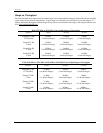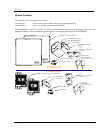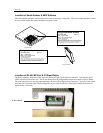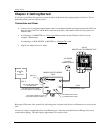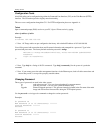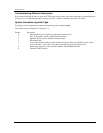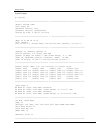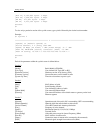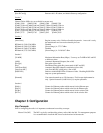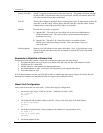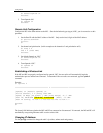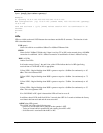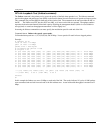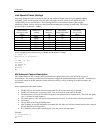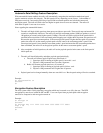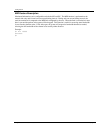
Configuration
Trango Broadband Wireless — Atlas5010 page 15
[Peer IP Config] Remote radio’s IP subnet, and default Gateway configuration
Section 3
Channel Table: (MHz, n/a: not available in current area)
[Ch#01] 5260 [Ch#02] 5280 [Ch#03] 5300 [Ch#04] 5320
[Ch#05] 5340 n/a [Ch#06] 5480 n/a [Ch#07] 5500 n/a [Ch#08] 5520 n/a
[Ch#09] 5540 n/a [Ch#10] 5560 n/a [Ch#11] 5580 n/a [Ch#12] 5600 n/a
[Ch#13] 5620 n/a [Ch#14] 5640 n/a [Ch#15] 5660 n/a [Ch#16] 5680 n/a
[Ch#17] 5700 n/a [Ch#18] 5720 n/a [Ch#19] 5735 [Ch#20] 5755
[Ch#21] 5775 [Ch#22] 5795 [Ch#23] 5815 [Ch#24] 5835
Section 4
[Area Code] Region (country code). Defines allowable frequencies. Area code is set by
the manufacturer and can not be altered by the user.
RF Band #1 (5180..5240 MHz) Disabled
RF Band #2 (5260..5325 MHz) [Power Range] -4..7/7/7/7 dBm
RF Band #3 (5480..5720 MHz) Disabled
RF Band #4 (5735..5835 MHz) [Power Range] -4..21/19/18/17 dBm
Section 5
[Tx MIR] Maximum Information Rate (Mbps). User may set Tx MIR in MU and RU
to different values.
[ARQ] Automatic Retransmit Request (On or Off)
[Encrypt] Encryption (On or Off)
[Key] Hexidecimal Encryption Key (must match in MU and RU)
[Auto Rate Shift] Automatic Rate Shift (adaptive modulation) (On or Off)
[Auto Scan MU] Auto Scan MU (RU setting only). (On or Off)
[RSSI LED] Enable or disable RSSI LEDs on bottom of radio. Disabling RSSI LEDs
improves system performance.
[Remarks] User entered remarks up to 256 characters. Field accepts alpha numerics
only. Special characters (!@#$%^&*()\?/) require quotations.
Section 6
[Eth In] Counter for Ethernet packets which entered via the Ethernet port
[Eth Tx] Counter for Ethernet packets which exited via the Ethernet port
[RF Rx] Counter for Ethernet packets which entered via the wireless link
[RF Tx] Counter for Ethernet packets which exited via the wireless link
Chapter 3 Configuration
Key Concepts
Prior to configuring the radios it is important to understand several key concepts:
Master Unit (MU) The MU is typically considered the primary radio within the link. For management purposes
it is recommended to install the MU closest to the head-end of the network.



